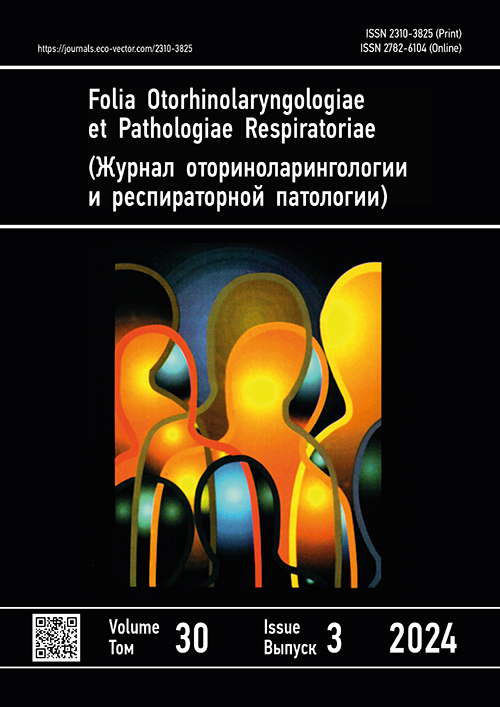Surgical treatment of patients with nasal and paranasal sinus conditions associated with seizure syndrome
- Авторлар: Boenko D.S.1, Talalaenko I.A.1, Boenko N.D.1, Ginkut V.N.1, Chubar V.A.1, Talalaenko L.R.1, Boenko S.D.1
-
Мекемелер:
- Donetsk State Medical University named after M. Gorky
- Шығарылым: Том 30, № 3 (2024)
- Беттер: 242-249
- Бөлім: Clinical otorhinolaryngology
- ##submission.dateSubmitted##: 16.10.2024
- URL: https://journals.eco-vector.com/2310-3825/article/view/637135
- DOI: https://doi.org/10.33848/fopr637135
- ID: 637135
Дәйексөз келтіру
Аннотация
There are few publications in the current medical literature that address the effects of ENT conditions on the onset and clinical course of seizure syndrome. The authors present and evaluate two interesting case reports on the treatment of patients with chronic rhinologic conditions in combination with epilepsy and seizures. In both patients, successful surgical treatment had a positive effect on the clinical course of the convulsive states; the seizures resolved completely, headaches and facial pain disappeared, and the emotional state improved. Endonasal surgery was made possible by the use of modern medical technology such as cone beam computer tomography and endoscopic surgery. It was concluded that abnormal changes in the intranasal structures and paranasal sinuses of both the anterior and posterior groups may induce seizures in epileptic syndrome. Clinical improvement in patients with epileptic seizures is achieved by treating the intranasal structures, normalizing nasal breathing and cleaning the paranasal sinuses. The problem of rhinogenic induction of convulsive states requires further research.
Негізгі сөздер
Толық мәтін
Авторлар туралы
Dmytrii Boenko
Donetsk State Medical University named after M. Gorky
Хат алмасуға жауапты Автор.
Email: dboenko@gmail.com
ORCID iD: 0009-0007-8424-0341
SPIN-код: 7579-0833
MD, Dr. Sci. (Medicine)
Ресей, DonetskIrina Talalaenko
Donetsk State Medical University named after M. Gorky
Email: i.talalaenko@yandex.ru
ORCID iD: 0009-0008-8530-4201
SPIN-код: 8795-3177
MD, Cand. Sci. (Medicine)
Ресей, DonetskNikolay Boenko
Donetsk State Medical University named after M. Gorky
Email: ndboenko@gmail.com
ORCID iD: 0009-0006-1463-3513
Ресей, Donetsk
Victor Ginkut
Donetsk State Medical University named after M. Gorky
Email: viknikgin@mail.ru
ORCID iD: 0009-0009-4634-8268
SPIN-код: 1164-4472
MD, Cand. Sci. (Medicine)
Ресей, DonetskVictoriya Chubar
Donetsk State Medical University named after M. Gorky
Email: vikchubar@yandex.ru
ORCID iD: 0009-0009-1090-2028
Ресей, Donetsk
Ludmila Talalaenko
Donetsk State Medical University named after M. Gorky
Email: i.talalaenko@yandex.ru
ORCID iD: 0009-0007-4940-7417
Ресей, Donetsk
Sergey Boenko
Donetsk State Medical University named after M. Gorky
Email: dboenko@gmail.com
ORCID iD: 0009-0006-0877-8978
Ресей, Donetsk
Әдебиет тізімі
- Boenko DS, Talalaenko IA, Boenko ND, et al. Surgical treatment of pathology of the nose and paranasal sinuses in patients with convulsive syndrome. In: Proceedings of the scientific conference V All-Russian Congress of the National Medical Association of Otolaryngologists of Russia. Sochi – Saint Petersburg, November 1–3, 2023. Saint Petersburg: Polyforum Group; 2023. P. 107. (In Russ.)
- Lebedev KE, Mamatkhanov MR. Indications and general principles for surgical treatment of epilepsy (review). Pediatric Neurosurgery and Neurology. 2016;(2):66–78. EDN: YTWTSR
- Boyenko SK, editor. Functional endoscopic rhinosurgery. Donetsk: Nord-Press; 2010. 234 p.
- Karlov VA. Neurology of the face. Moscow: Meditsina; 1991. P. 86–95. (In Russ.)
- Guidelines for epidemiologic studies on epilepsy. Commission on Epidemiology and Prognosis, International League Against Epilepsy. Epilepsia. 1993;34(4):592–596. doi: 10.1111/j.1528-1157.1993.tb00433.x
- Fiest KM, Sauro KM, Wiebe S, et al. Prevalence and incidence of epilepsy. Neurology. 2017;88(3):296–303. doi: 10.1212/WNL.0000000000003509
- Global, regional and national burden of epilepsy, 1990–2016: a systematic analysis for the Global Burden of Disease Study 2016. Lancet Neurol. 2019;18(4):357–375. doi: 10.1016/S1474-4422(18)30454-X
- Shorvon SD. The etiologic classification of epilepsy. Epilepsia. 2011;52(6):1052–1057. doi: 10.1111/j.1528-1167.2011.03041.x
- Bukov VA, Felberbaum RA. Reflex influences from the upper respiratory tract. Moscow: Meditsina; 1980. P. 62–80. (In Russ.)
- Boenko DS. Clinic, diagnostics and endoscopic surgical treatment of inflammatory diseases of the posterior group of paranasal sinuses [dissertation abstract]. Donetsk; 2020. 38 p. (In Russ.) Available from: https://vak.mondnr.ru/wp-content/uploads/2020/Avtoreferat/avtoreferat_boenko.pdf
- Grashchenkov NI, Kassil GN. Physiology in clinical practice. Moscow: Nauka; 1966. P. 46–84. (In Russ.)
- Gusev EI, Gekht AB. Brain diseases — medical and social aspects. Moscow: Buki-Vedi; 2016. 767 p. (In Russ.)
- Karpischenko SA, Voloshina AV, Stancheva OA. Pain syndrome with isolated sphenoiditis: our experience in the diagnosis, treatment. Folia Otorhinolaryngologiae et Pathologiae Respiratoriae. 2017;23(2):4–6. EDN: YUOKOH
- Boenko DS, Lutsky IS. Somnambulism in a patient with chronic sphenoiditis. Rhinology. 2012;(1):51–53. (In Russ.)
- Boyenko DS. Morphological substrate of headache in sphenoiditis. Journal of ear, nose and throat diseases. 2013;(5):28. (In Russ.)
- Sagalovich BM. Physiology and pathophysiology of the upper respiratory tract. Moscow: Meditsina; 1967. 328 p. (In Russ.)
- Parent JM, Kron MM. Neurogenesis and epilepsy. Epilepsia. 2010;51:45. doi: 10.1111/j.1528-1167.2010.02831.x
- Filimonov SV, Krivoshein VE, Balabushko MYa. Pathological rhinocerebral reaction in case of violation of the nasal cavity structures. Klinicheskaya bolnitsa. 2018;(1(23)):27–29. (In Russ.) EDN: YWSTGG
- Pitkänen A, Galanopoulou AS, Moshé SL, Buckminster PS. What Can We Model? In: Models of Seizures and Epilepsy. 2nd ed. Elsevier; 2017. P. 1–3. doi: 10.1016/B978-0-12-804066-9.00001-8
- Guekht A. Epilepsy, comorbidities and treatments. Curr Pharm Des. 2017;23(37):5702–5726. doi: 10.2174/1381612823666171009144400
Қосымша файлдар










